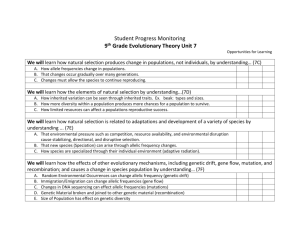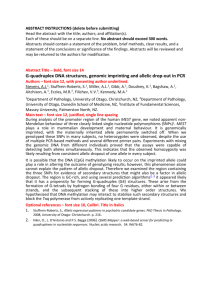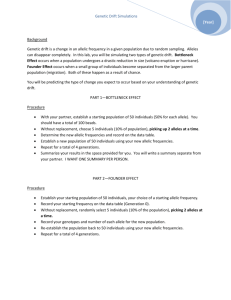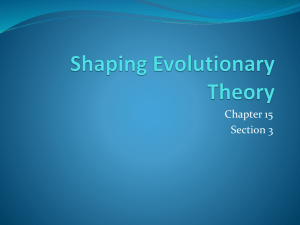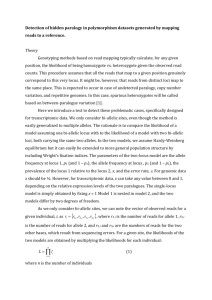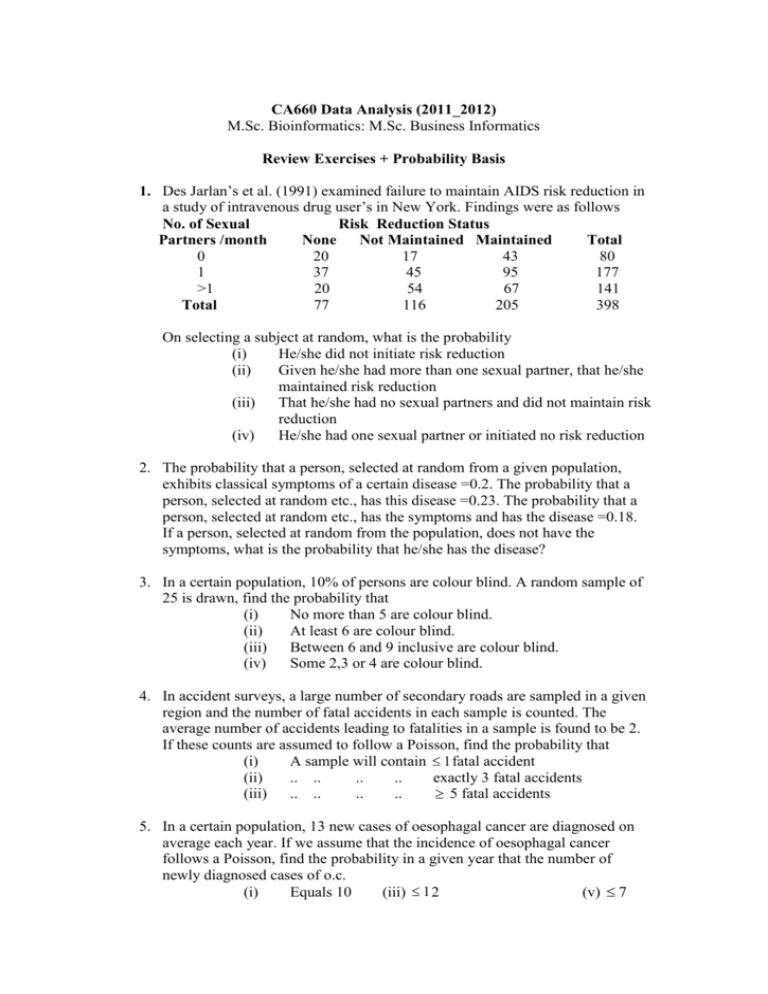
CA660 Data Analysis (2011_2012)
M.Sc. Bioinformatics: M.Sc. Business Informatics
Review Exercises + Probability Basis
1. Des Jarlan’s et al. (1991) examined failure to maintain AIDS risk reduction in
a study of intravenous drug user’s in New York. Findings were as follows
No. of Sexual
Risk Reduction Status
Partners /month
None
Not Maintained Maintained
Total
0
20
17
43
80
1
37
45
95
177
>1
20
54
67
141
Total
77
116
205
398
On selecting a subject at random, what is the probability
(i)
He/she did not initiate risk reduction
(ii)
Given he/she had more than one sexual partner, that he/she
maintained risk reduction
(iii)
That he/she had no sexual partners and did not maintain risk
reduction
(iv)
He/she had one sexual partner or initiated no risk reduction
2. The probability that a person, selected at random from a given population,
exhibits classical symptoms of a certain disease =0.2. The probability that a
person, selected at random etc., has this disease =0.23. The probability that a
person, selected at random etc., has the symptoms and has the disease =0.18.
If a person, selected at random from the population, does not have the
symptoms, what is the probability that he/she has the disease?
3. In a certain population, 10% of persons are colour blind. A random sample of
25 is drawn, find the probability that
(i)
No more than 5 are colour blind.
(ii)
At least 6 are colour blind.
(iii) Between 6 and 9 inclusive are colour blind.
(iv)
Some 2,3 or 4 are colour blind.
4. In accident surveys, a large number of secondary roads are sampled in a given
region and the number of fatal accidents in each sample is counted. The
average number of accidents leading to fatalities in a sample is found to be 2.
If these counts are assumed to follow a Poisson, find the probability that
(i)
A sample will contain 1 fatal accident
(ii)
.. ..
..
..
exactly 3 fatal accidents
(iii) .. ..
..
..
5 fatal accidents
5. In a certain population, 13 new cases of oesophagal cancer are diagnosed on
average each year. If we assume that the incidence of oesophagal cancer
follows a Poisson, find the probability in a given year that the number of
newly diagnosed cases of o.c.
(i)
Equals 10
(iii) 1 2
(v) 7
(ii)
8
(iv) between 9 and 15 inclusive
6. Complete the following decision tree and determine the decision based on the
maximum expected payoff. Let P{S1}= 0.4, P{S2}= 0.2, P{S3}= 0.1 and
P{S4}= 0.3.
50
35
20
15
Branches are
labelled S1 to S4
from top to bottom
in each case
40
55
45
41
20
30
35
43
7. Worldwide production of Japanese car industry in 1989 was as follows, (in
thousands of vehicles worldwide).
Manufacturer
Toyota
Nissan
Honda
Mitsubishi
Mazda
Suzuki
Daihatsu
Fuji(H)
Isuzu
(i)
(ii)
(iii)
(iv)
Thousands
of Vehicles
Worldwide
4,448
3,009
1,861
1,560
1,270
868
664
563
559
Are classifications mutually exclusive?
If a Japanese vehicle is selected at random, what is the
probability that it is neither a Toyota, a Nissan, or a Honda?
Suppose two vehicles are selected at random from this worldwide
production. What is the probability that both are Toyotas or both
Nissans?
For the two vehicles in (iii), what is the probability that at least
one is a Toyota?
8. Mutation is the ultimate source of new alleles. Suppose the allelic frequency in
a native population is p n0 , where proportion mi relative to the native
population, migrates from i th population among k, to the native population
every generation, (and where allelic frequency among immigrants from i th
population is pi), then allelic frequency in the mixed population is:
k
k
p n1 1 mi p n 0 (mi pi )
i 1
i 1
Similarly, if mutation rate from wild to mutant is u and reverse mutation rate
= v per generation, then give:
(i)
The frequency p n1 of the wild type after one generation, assuming
p n0 is the wild type frequency in the population of the previous
generation.
(ii)
The equilibrium condition for p n0 (setting allelic frequency change
= 0)
Supposing selection is considered (either artificial or natural). If we have a
two allele system, with fitness (1-Coefficient selection) for the three
genotypes AA, Aa and aa = f1,f2,f3 respectively, what form would you expect
p n1 (allelic frequency for allele A) to take?
(Let p n0 be the allelic frequency for A in the population before selection and
consider the Coefficient of selection to be the measure of disadvantage of a
given genotype in a population).
9. Referring to the example in the lecture on introducing a new computer tablet
to the market, the closeness of the expected payoff figures means that the
management want to perform a sensitivity analysis before making a decision.
The following sets of probabilities are to be used. How sensitive, (from your
analysis), are decisions based, respectively, on minimax and maximum
expected payoff strategies?
P{S1}
0.1
0.1
0.1
0.1
0.2
P{S2}
0.5
0.5
0.5
0.5
0.5
P{S3}
0.2
0.1
0.3
0.2
0.2
P{S4}
0.2
0.3
0.1
0.2
0.1

